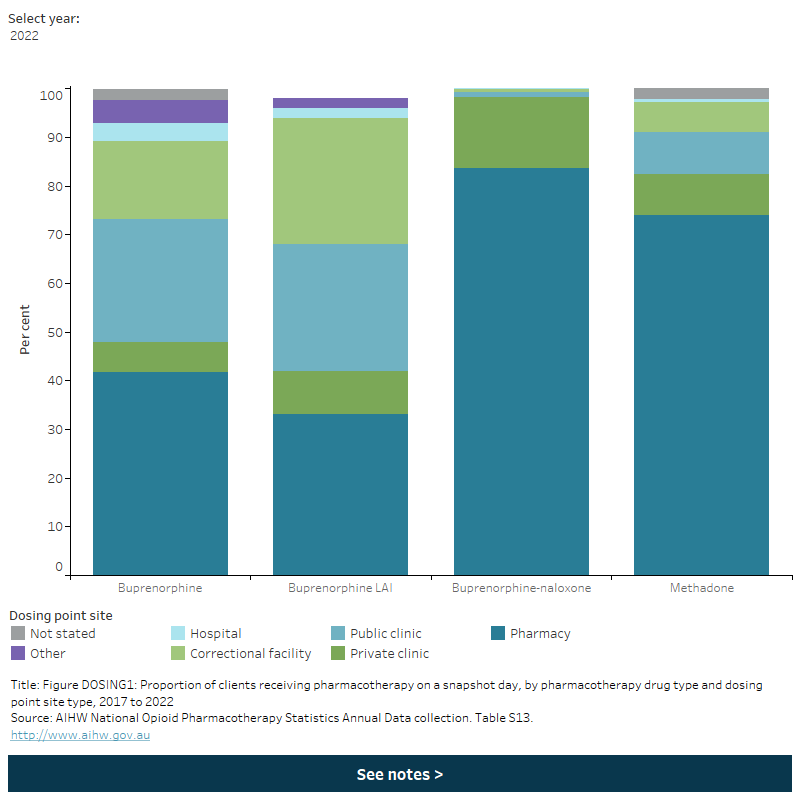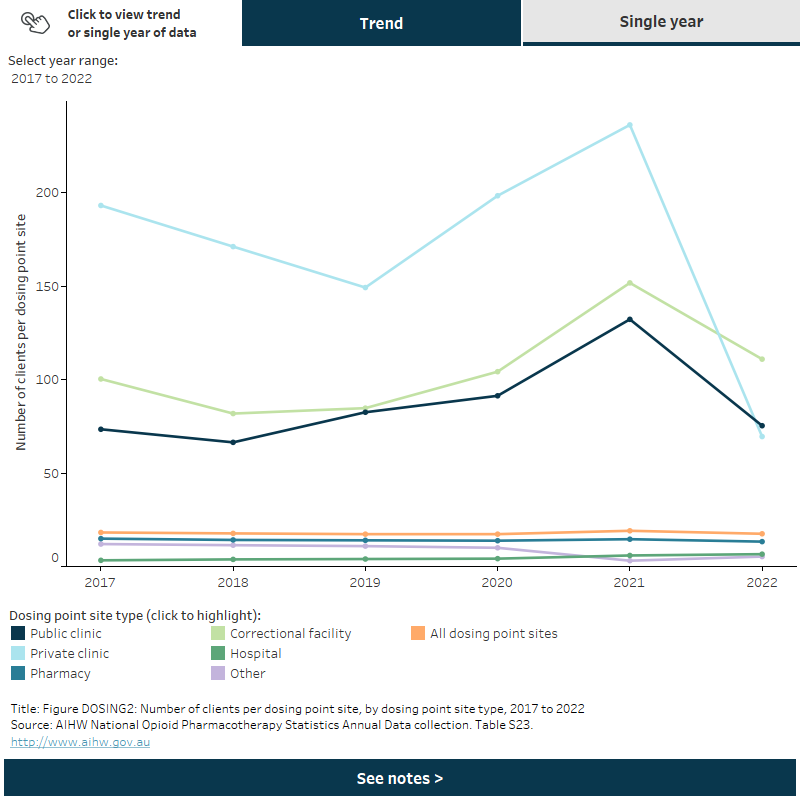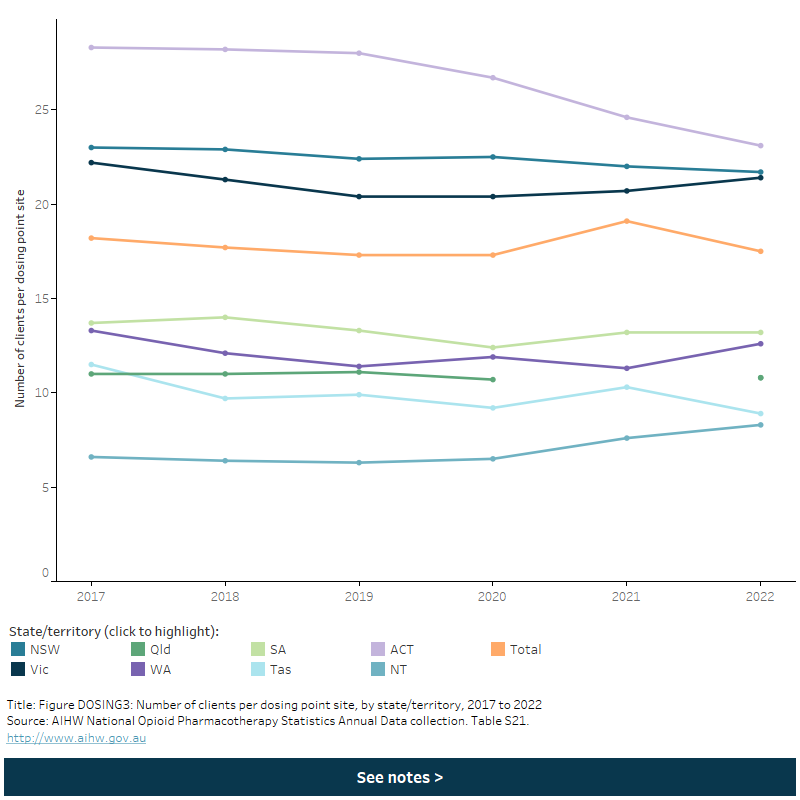Dosing points
On this page:
- Where were opioid pharmacotherapy drugs provided?
- What was the relationship between opioid pharmacotherapy clients and dosing point sites?
- Pharmacotherapy drug type
- Client characteristics
- Number of opioid pharmacotherapy clients per dosing point site
- What was the geographic location of dosing point sites?
Clients attend dosing point sites regularly to take their prescribed medication under the supervision of a pharmacist or other health professional. Dosing point site types include public clinics, private clinics, pharmacies, and correctional facilities.
Where were opioid pharmacotherapy drugs provided?
Most opioid pharmacotherapy dosing points were located in pharmacies.
In 2021–22, there were 3,189 dosing point sites nationally (Table DOSING1). Almost 9 in 10 sites (85% or 2,717 sites) were located in pharmacies. This was consistent across all states and territories (Table S17).
| Dosing point site type | NSW | Vic | Qld | WA | SA | Tas | ACT | NT | Total | Total (%) |
|---|---|---|---|---|---|---|---|---|---|---|
| Public clinic | 40 | — | 42 | 1 | 3 | 3 | 1 | 3 | 93 | 2.9 |
| Private clinic | 10 | — | 62 | — | — | — | — | — | 72 | 2.3 |
| Pharmacy | 884 | 672 | 584 | 234 | 211 | 76 | 40 | 16 | 2,717 | 85.2 |
| Correctional facility | 1 | 17 | 14 | 1 | 9 | 1 | 1 | 2 | 46 | 1.4 |
| Other | 204 | 18 | 32 | — | 2 | 2 | 1 | 1 | 260 | 8.2 |
| Not stated | 1 | — | — | — | — | — | — | — | 1 | |
| Total | 1,140 | 707 | 734 | 236 | 225 | 82 | 43 | 22 | 3,189 | 100.0 |
| Total (%) | 35.7 | 22.2 | 23.0 | 7.4 | 7.1 | 2.6 | 1.3 | 0.7 | 100.0 | . . |
— Nil or rounded to zero.
Notes
- See tables T1 and T2 in the Technical notes for more information about NSW.
- The category 'Other' includes hospitals, mobile dosing sites, community health clinics, non‑government organisations, and doctors' surgeries.
- The category 'Other' includes “Not stated" as the data cannot be reported separately.
- The number of dosing point sites where clients receive treatment during the collection year (that is, the financial year).
- Correctional facility dosing point sites in NSW and WA are grouped as 1 site.
- Through improved data quality initiatives, NSW identified small data errors in dosing point site data for private and public clinics, which were corrected for 2021 and 2022.
Source: AIHW National Opioid Pharmacotherapy Statistics Annual Data collection. Table S17.
There has been a 3.4% (3,189) increase in the number of dosing sites from 2019–20 (3,084) (the last time comparable data were available). Between 2010–11 and 2019–20, there was a 40% increase in the number of dosing point sites (Table S17).
What was the relationship between opioid pharmacotherapy clients and dosing point sites?
Pharmacotherapy drug type
Most pharmacotherapy clients received their opioid pharmacotherapy treatment at a pharmacy.
On a snapshot day in 2022, most clients (65% or 36,191 clients) received pharmacotherapy treatment at a pharmacy (Table S13). This was the most common dosing point site regardless of the pharmacotherapy drug type that clients received. Among clients receiving:
- Methadone, almost 3 in 4 clients (74% or 21,409 clients) dosed at pharmacies and 1 in 12 clients dosed at either public clinics (8.5% or 2,460) or private clinics (8.5% or 2,453).
- Buprenorphine-naloxone, over 4 in 5 (84% or 7,859 clients) dosed at pharmacies (excludes NSW data).
- Buprenorphine LAI, 1 in 3 (33% or 1,417 clients) dosed at pharmacies and around 1 in 4 dosed at either public clinics (26% or 1,121) or correctional facilities (26% or 1,120) (excludes NSW data) (Figure DOSING1; Table S13).
The number of clients receiving different buprenorphine formulations in New South Wales cannot be compared, as New South Wales groups all clients receiving buprenorphine-naloxone or buprenorphine LAI together with clients receiving buprenorphine. Refer to Table S14 for more information.
Figure DOSING1: Proportion of clients receiving pharmacotherapy on a snapshot day, by pharmacotherapy drug type and dosing point site type, 2017 to 2022
On a snapshot day in 2022, most clients received pharmacotherapy treatment at a pharmacy. The proportion of clients who received pharmacotherapy at pharmacies ranged from 33% for buprenorphine LAI to 83.6% for buprenorphine-naloxone.

Refer to the Data tables for more information.
Client characteristics
Client characteristics (including age, sex, and prescriber type) can differ according to the type of dosing point site where clients receive treatment.
Information on client characteristics is assessed using unit record data. In 2022, unit record data were provided by all states and territories except Victoria and Queensland. The following sections on client age and sex are based on these data.
Age of clients: Consistent with previous years, pharmacies continued to treat an older client group than other dosing point site types, while correctional facilities treated a younger client group.
On a snapshot day in 2022 (excluding data for Victoria and Queensland):
- Clients aged 50 and over were around 4 times more likely to dose at pharmacies compared to correctional facilities:
- Over 2 in 5 clients (43% or 6,777 clients) who dosed at pharmacies were aged 50 and over, making it the most common age group for this dosing point site type.
- Just 1 in 8 clients (12% or 387) at correctional facilities were aged 50 and over.
- Almost 2 in 5 clients who dosed at correctional facilities were aged 30–39 (39% or 1,279) or under 30 years (22% or 713). Comparatively, around 1 in 5 clients of pharmacies were aged 30–39 (18% or 2,825 clients) or under 30 (4.5% or 703 clients).
- Around 1 in 3 clients who dosed at public clinics (33% or 2,057 clients) or private clinics (37% or 870) were aged 40–49.
- The most common age groups for clients who dosed at hospitals were aged 30–39 (35% or 238) or 40–49 (33% or 225) (Table S29).
Sex of clients: On a snapshot day in 2022, all dosing point site types from the selected states and territories treated more males than females (excluding data for Victoria and Queensland). This is consistent with the overall proportion of males and females receiving pharmacotherapy treatment.
On a snapshot day in 2022 (excluding data for Victoria and Queensland):
- The proportion of clients who were male ranged from 64% (9,936 clients) for pharmacies to 92% (3,027) for correctional facilities.
- The proportion of clients who were female ranged from 8.0% (263 clients) for correctional facilities to 36% (5,664) for pharmacies.
- Female clients were more likely to dose at pharmacies (59% of female clients, compared with 45% of male clients).
- Male clients were almost 5 times as likely as female clients to dose in correctional facilities (14% of male clients, compared with 2.7% of female clients) (Table S30).
Prescriber type: Information on prescriber type by dosing point site type is assessed using unit record data. In 2022, unit record data were provided by all states and territories except Victoria and Queensland. Based on these data, around half of all clients (49%) received pharmacotherapy at pharmacies in 2022. Across all dosing point site types from the selected states and territories, the most common prescriber type was private prescriber (50% of clients).
- Almost 1 in 3 clients (31%) received pharmacotherapy at pharmacies from private prescribers.
- A further 1 in 3 clients received pharmacotherapy at either pharmacies from public prescribers (16%) or public clinics from public prescribers (17%) (Table S31).
Number of opioid pharmacotherapy clients per dosing point site
In 2022, pharmacotherapy dosing point sites dosed an average of 18 clients each.
On a snapshot day in 2022, dosing point sites dosed an average of 18 clients each nationally. This represents an increase since 2020 (17 clients per site) (when comparable data were available) but a decline from 2011 (21 clients).
The number of clients per dosing point site varied by site type. On average:
- Private clinics (New South Wales and Queensland only) had the highest number of clients per dosing point site (70 clients per site).
- Pharmacies dosed 13 clients per site (Figure DOSING2; Table S23).
- Correctional facilities dosed an average of 111 clients per site. However, this number is inflated as New South Wales and Western Australia each report all correctional dosing point sites as operating under a ‘single’ site rather than counting individual correctional dosing point sites. This significantly increases the number of clients per site. On the snapshot day in 2022, New South Wales and Western Australia recorded only 1 site with clients receiving treatment (Table S23).
Figure DOSING2: Number of clients per dosing point site, by dosing point site type, 2017 to 2022
On a snapshot day in 2022, correctional facility had the highest number of clients per dosing point on average (110.9 clients). Between 2017 and 2022, there were overall increases from 2017 to 2021 in the number of clients per dosing point site for correctional facilities (151.7 clients per dosing point site in 2021) as well as private clinics and public clinics (236.2 and 132.2 clients per dosing point site in 2021, respectively) and then decrease in 2022 (110.9, 69.5 and 75.3 clients per dosing point site in 2022, respectively).

Refer to the Data tables for more information.
On a snapshot day in 2022, 7 in 10 (71% or 2,251) dosing point sites treated between 1 and 20 clients:
- 38% treated 1–5 clients;
- 16% treated 6–10 clients; and
- 16% treated 11–20 clients.
Of the dosing point sites treating more than 50 clients (6.1% of all dosing point sites), most were located in New South Wales, Victoria and Queensland (Table S20). The Australian Capital Territory had the highest ratio of clients per dosing point site (23 clients per site), while the Northern Territory had the lowest (8.3 clients) (Figure DOSING3; Table S21).
Figure DOSING3: Number of clients per dosing point site, by state/territory, 2017 to 2022
On a snapshot day in 2022, the Australian Capital Territory had the highest number of clients per dosing point (23.1 clients). The Northern Territory had the lowest ratio of clients per dosing point (8.3 clients). Between 2017 and 2022, the number of clients per dosing point site increased from 18.2 in 2017 to 19.1 in 2021, then decreased to 17.5 in 2022, nationally (data for 2021 exclude Queensland).

Refer to the Data tables for more information.
What was the geographic location of dosing point sites?
Across Australia (excluding Queensland and Western Australia), most opioid pharmacotherapy dosing point sites were located in Major cities.
On a snapshot day in 2022, most dosing point sites were located in Major cities (62% or 1,376 sites) (dosing point location data for Queensland and Western Australia were not available). A further 26% (573) of sites were located in Inner regional areas, and 10% (230) were located in Outer regional areas.
Since 2014, rates of dosing point sites (per 100,000 population) in state and territory remoteness areas have generally increased. Larger increases have occurred mainly in more regional areas (e.g. Outer regional, Remote and Very remote areas) (Table S18). However, these rates do not indicate the number of clients receiving opioid pharmacotherapy treatment at each dosing point site in these areas. This information is not currently collected by the NOPSAD collection. Caution should be used when comparing rates due to missing data and the effect of border closures due to the COVID-19 pandemic on Australian Estimated Residential Population (ERP) estimates in 2020–21. See Technical notes for further information.
Figure DOSING4 shows the number of dosing point sites by Statistical Area Level 2 (SA2), excluding Queensland and Western Australia. The number of dosing point sites within an SA2 may be driven by a range of factors including policy and legislation in each jurisdiction, whether all dosing point sites in an SA2 reported data on the snapshot day and the size of the population in each SA2. Refer to the Glossary and Technical notes for more information.
How to use the map:
- Map navigation: Use the zoom in, zoom out and home buttons to explore the map. You can also click and drag within the map and use the mouse wheel to zoom in and out.
- Category selection: Select a state or territory from the left-hand selection panel to view information regarding the area of interest.
- Map pop-ups: Click on the map and a pop-up will open with additional information regarding the area of interest.
- Search: Search the map by address, suburb, post code, major cities and SA2.
- Legend selection: Filter the map by clicking on the numbers in the legend. The colour shading indicates the number of opioid pharmacotherapy dosing points in an SA2, with darker shades indicating a higher number of pharmacotherapy dosing points.
The map can be viewed in most browsers. For more information on browser compatibility, see Supported browsers.


